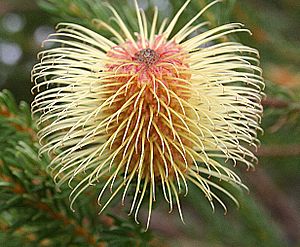Banksia subser. Longistyles facts for kids
Quick facts for kids Banksia subser. Longistyles |
|
|---|---|
 |
|
| Banksia pulchella (Teasel Banksia), a plant in this group | |
| Scientific classification | |
| Kingdom: | |
| (unranked): | |
| (unranked): | |
| Order: | |
| Family: | |
| Genus: | |
| Subgenus: | |
| Series: | |
| Subseries: |
B. subser. Longistyles
K.R.Thiele
|
Banksia subser. Longistyles is a scientific name for a small group of Banksia plants. It was first named by a scientist named Kevin Thiele in 1996. However, another scientist, Alex George, later decided not to use this grouping in 1999.
How Scientists Group Plants (Cladistics)
Scientists use something called cladistics to figure out how living things are related. It's like building a family tree for plants! In 1996, Kevin Thiele and Pauline Ladiges studied Banksia plants using this method. They found that some plants were related in a different way than previously thought.
Their study suggested that a plant called B. tricuspis (Lesueur Banksia) was closely related to other plants in a group called B. ser. Abietinae. To make the family tree accurate, they suggested moving B. tricuspis into that group.
Within this larger group, they found four smaller related groups. B. subser. Longistyles was the name they gave to one of these smaller groups. This group included plants like:
- B. violacea
- B. laricina
- B. incana
- B. tricuspis
- B. pulchella
- B. meisneri (which has two varieties: B. m. var. meisneri and B. m. var. ascendens)
Naming and Defining the Group (Taxonomy)
The name Longistyles comes from Latin. Longus means "long" and stylus means "style". The "style" is a part of a flower. This group was named because its plants have very long and thin styles.
They also have flower parts called "perianth limbs" that are smoothly rounded. These parts do not have a sharp ridge and have thicker edges.
Even though Thiele and Ladiges created this new way of grouping Banksia plants, it didn't last long. In 1999, Alex George published his own updated classification for the Banksia genus. He looked at some of Thiele and Ladiges' findings but decided not to use their overall arrangement. So, B. subser. Longistyles was no longer used as a formal group, and B. tricuspis was moved out of B. ser. Abietinae again.
New Discoveries (Recent Developments)
Since 1998, a scientist named Austin Mast has been studying the DNA of Banksia plants. DNA studies help scientists understand plant relationships even better.
His research shows that the plants originally put into B. subser. Longistyles might not all be as closely related as once thought. They seem to belong to three different, separate groups based on their DNA.
In 2007, Mast and Thiele started a new way of classifying Banksia. They moved another group of plants called Dryandra into the Banksia genus. They also created a new subgenus called B. subg. Spathulatae for plants with spoon-shaped seed leaves (called cotyledons). All the plants that were once in subseries Longistyles now fit into this new B. subg. Spathulatae. Scientists are still working on a complete new classification based on these DNA studies.

